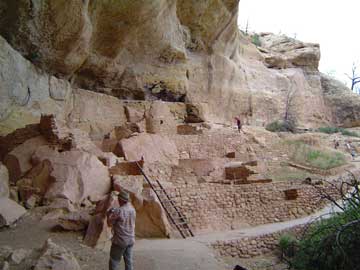|
News Notes
Geoarchaeology
Climate to blame in cultural collapses
 |
| The Anasazi people who carved villages out of cliffsides in the Four Corners region of the American Southwest disappeared suddenly, possibly due to climate change that made food and water sources scarce. Researchers are now linking several past periods of climate change with failed civilizations. Photograph is by Deborah East. |
Humans are generally considered the villain when it comes to modern climate change. But in the past, humans were the victims, rather than the perpetrators, of abrupt climate change, according to a growing pool of evidence that suggests that variations in rainfall over the last several thousand years severely disrupted human settlements.
In the time since the last major ice age, Earth has experienced significant and sudden variations in climate. Some of these blips occurred in the Holocene — the last 10,000 years — when humans were busily expanding their presence across the globe, creating societies, and sometimes adapting to the conditions around them and sometimes failing.
Just over a decade ago, archaeologist Harvey Weiss of Yale University was studying one of these apparently failed civilizations, in part of what is now Syria. He noted that the settlement seemed to have been abandoned about 4,200 years before present, as dated by radiocarbon dating, at just the same time as a significant climate change event caused the middle latitudes of many parts of the world, including Africa and Asia, to suffer droughts.
Since connecting that natural event with the cultural one, many scientists have sought to link historic and prehistoric abrupt climate change events to changes in human societies. In a paper published in Quaternary Research in November, Weiss and paleoclimatologist Michael Staubwasser at the University of Hannover attempt to make the case that at least three instances of abrupt Holocene climate change led to major adaptations in human activity.
One major abrupt climate change event took place 8,200 radiocarbon years before present. Evidence for this change, which manifested as a 150-year-long cold period, originally came from ice cores in Greenland. Archaeological records show that humans living at this time in what is now the Middle East were cultivating cereal crops such as barley, and living in villages. The drought that accompanied the cold weather in this part of the world led to the shrinking of those villages that relied on water from rainfall, and not irrigation.
Staubwasser and Weiss describe another well-characterized abrupt change that took place 5,200 radiocarbon years before present. The dates of this apparent drought seem to coincide with widespread cultural collapses in southern Mesopotamia along the Euphrates and Tigris rivers, which would have experienced a weakened flow, reducing irrigation that was already in place by this time. Changes in agriculture as evidenced by pollen dated to this period also suggest that some groups turned back to crops that fared better in drier conditions. Settlements in the dry interior of Arabia were abandoned around this time.
Furthermore, signs of the droughts 4,200 radiocarbon years before present, which Weiss first saw evidence of in modern-day Syria, have since been found everywhere from the eastern Mediterranean to western Asia. Staubwasser acknowledges, however, that the dating of this period may be off by more than usual — as much as 200 years in either direction — although some individual records of the cultural events have been dated to within 35 years, he says. But such precision is not achieved in every archaeological record, he says, and is usually not achieved in paleoclimate records.
Such uncertainties in the dating of climate change and archaeological sites leave some researchers uncomfortable. “I lean to the skeptical side” regarding the exact timing of connections between humans and climate, says David Anderson, a paleoclimatologist at NOAA’s National Climatic Data Center in Boulder, Colo. “I am interested in stronger evidence,” he says, including tighter dates.
But Staubwasser says that the team’s evidence is “as direct as it can get,” given inherent uncertainties in radiocarbon dating. To bolster the connection between climate and civilization, he says that he hopes to eventually “work out the mechanisms of climate change, not just report it.” By mapping out how physical alterations in currents, wind flow and other weather patterns affect each other, he says, looking into past climates may help predict how our climate might change in the future — and how we may need to adapt.
Katherine Unger
Geotimes contributing writer
Links:
"Trapped in the ice," Geotimes,
March 2006
"Mesopotamian climate change,"
Geotimes, February 2004

 Subscribe
Subscribe

